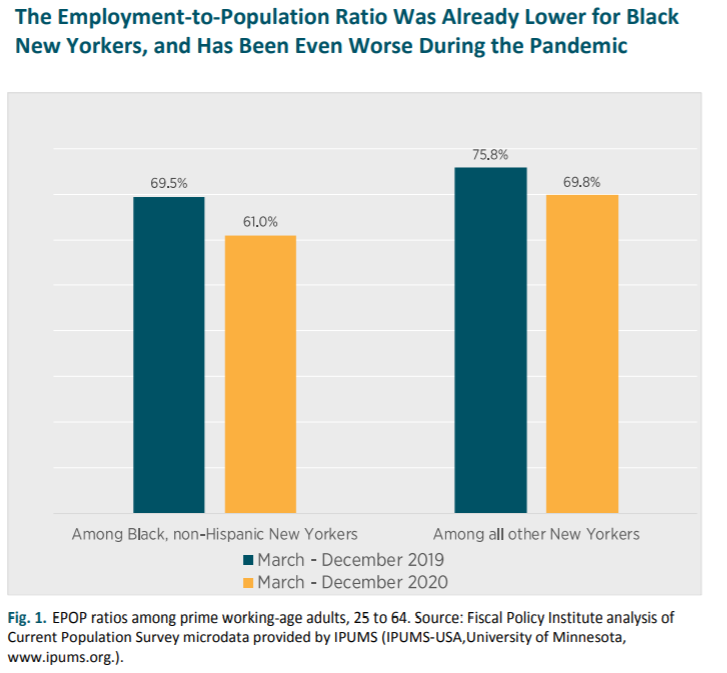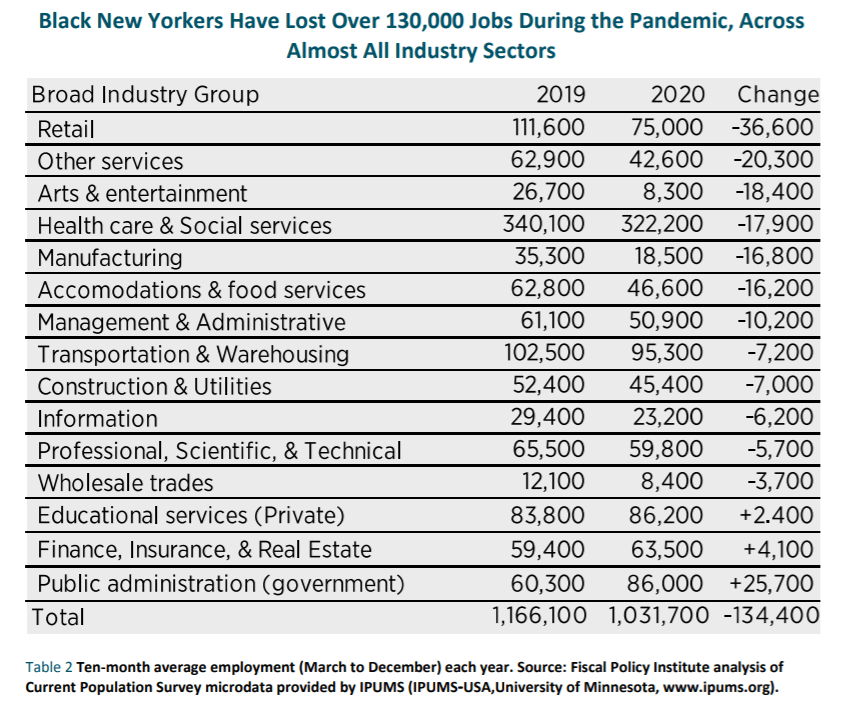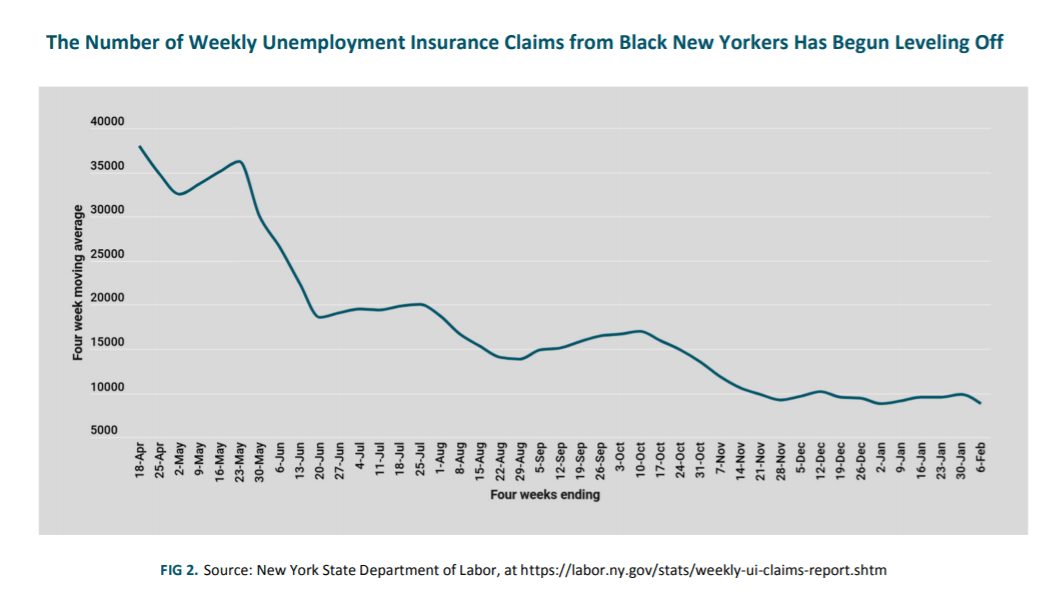Fact Sheet: Black New York Workers Have Been Hit Hard By The Pandemic Statewide
March 24, 2021 |
THE COVID‐19 PANDEMIC HAD AN UNPRECEDENTED EFFECT ON THE JOBS AND INCOMES OF NEW YORK STATE RESIDENTS, in addition to upending social norms and taking the lives of thousands. However, the pandemic’s burden was not evenly distributed across our population. The Fiscal Policy Institute found that Black workers statewide, who already had a higher rate of unemployment prior to the pandemic, experienced even greater losses.
Our first analysis compares the employment measures among Black New Yorkers between March to November 2019 and March to November 2020 – in other words, before and during the pandemic. While unemployment (the U‐3 rate) among Black adults has always been higher than that across the whole state population, we see (in Table 1) that both rates escalated due to pandemic layoffs, so that, on average, one in seven Black adults were jobless during these nine pandemic months, compared to one in fourteen during “normal” times.

However, the U‐3 numbers hide two related pandemic effects: thousands of Black adults across the state left the Labor Force entirely (note the drop in Labor Force Participation), meaning that they gave up on looking for paid work and were therefore no longer counted in the U‐3 unemployment measure. The expanded unemployment rate (U‐6) includes these people; one in six Black adults across the state are counted here, compared to one in ten during “normal” times.
As has been noted by several commentators1, unemployment rates (even the more inclusive U‐6) do not tell the whole story. If we want to know how far we are from “full employment,” the metric we want is the portion of working‐age adults who actually have jobs, known as the Employment‐to‐Population Ratio, or EPOP. Figure 1 shows that this ratio was already lower for Black New Yorkers than others in 2019. But Black New Yorkers lost 8.5 percentage points in this measure during the ten months of the pandemic in 2020, compared with the rest of New York adults, who lost 6.0 percentage points.
far we are from “full employment,” the metric we want is the portion of working‐age adults who actually have jobs, known as the Employment‐to‐Population Ratio, or EPOP. Figure 1 shows that this ratio was already lower for Black New Yorkers than others in 2019. But Black New Yorkers lost 8.5 percentage points in this measure during the ten months of the pandemic in 2020, compared with the rest of New York adults, who lost 6.0 percentage points.
Job Losses by Industry
We then asked whether job losses among Black New Yorkers were centered in particular industries. Table 2 shows our estimates of job losses from the ten pre‐pandemic months March to December 2019 to the latest ten months for which we have data,2 March to December 2020.
One possible explanation for the substantial increase in government employment among Black New Yorkers (+25,700) may reflect the substantial hiring of unemployment insurance processors early in the pandemic period (among all other New Yorkers, there was a net loss of government jobs).
Black New Yorkers’ job losses were centered in Retail and Other services (one job in three lost in each); Arts & entertainment (more than two jobs in three lost); and Manufacturing (a loss of nearly one in two jobs); and Accommodations & Food services (one in four). Unfortunately, data limitations allow us no way to dig deeper into these different distributions.

Unemployment Insurance Claims
We do have another piece of data about how Black New Yorkers have fared during the pandemic: the number of initial unemployment insurance claims. The New York State Department of Labor publishes weekly fact sheets3 breaking out claimants by race, among other factors.4 These weekly numbers are quite volatile since it seems claims are reported whenever they are entered into the system, so our chart uses a four‐week moving average to smooth the data.
As of the week ending February 6, 2021, the total initial unemployment insurance filings by Black New Yorkers since the week ending March 28, 2020, was 838,473.

________________________________
1See, for example, “Why Top Economists Are Citing a Higher Jobless Rate,” by Jeanna Smialek, New York Times, February 23, 2021,
https://www.nytimes.com/2021/02/22/business/economy/unemployment‐rate‐covid.html
2The analysis for table 1 was done in December, and the one for figure 1 in early February. Thus the one‐month difference in the data ranges. (Our investigation of the data suggested that we would learn nothing new by extending the first analysis through December). We also concluded that, while survey samples for Black residents in the Current Population Survey were weak, they sufficed for these estimates. There were approximately 2,000 interviews of Black NY workers in each ten‐month sample.
3See https://labor.ny.gov/stats/weekly‐ui‐claims‐report.shtm
4Unlike the microdata sources used in the analyses for tables 1 and 2, the state does not exclude those filers who identify as Black and Hispanic from the counts of Black filers.
Download the fact sheet as a PDF
by Brent Kramer, PhD, Senior Economist, Fiscal Policy Institute
Fact Sheet: Black New York Workers Have Been Hit Hard By The Pandemic Statewide
March 24, 2021 |
THE COVID‐19 PANDEMIC HAD AN UNPRECEDENTED EFFECT ON THE JOBS AND INCOMES OF NEW YORK STATE RESIDENTS, in addition to upending social norms and taking the lives of thousands. However, the pandemic’s burden was not evenly distributed across our population. The Fiscal Policy Institute found that Black workers statewide, who already had a higher rate of unemployment prior to the pandemic, experienced even greater losses.
Our first analysis compares the employment measures among Black New Yorkers between March to November 2019 and March to November 2020 – in other words, before and during the pandemic. While unemployment (the U‐3 rate) among Black adults has always been higher than that across the whole state population, we see (in Table 1) that both rates escalated due to pandemic layoffs, so that, on average, one in seven Black adults were jobless during these nine pandemic months, compared to one in fourteen during “normal” times.

However, the U‐3 numbers hide two related pandemic effects: thousands of Black adults across the state left the Labor Force entirely (note the drop in Labor Force Participation), meaning that they gave up on looking for paid work and were therefore no longer counted in the U‐3 unemployment measure. The expanded unemployment rate (U‐6) includes these people; one in six Black adults across the state are counted here, compared to one in ten during “normal” times.
As has been noted by several commentators1, unemployment rates (even the more inclusive U‐6) do not tell the whole story. If we want to know how far we are from “full employment,” the metric we want is the portion of working‐age adults who actually have jobs, known as the Employment‐to‐Population Ratio, or EPOP. Figure 1 shows that this ratio was already lower for Black New Yorkers than others in 2019. But Black New Yorkers lost 8.5 percentage points in this measure during the ten months of the pandemic in 2020, compared with the rest of New York adults, who lost 6.0 percentage points.
far we are from “full employment,” the metric we want is the portion of working‐age adults who actually have jobs, known as the Employment‐to‐Population Ratio, or EPOP. Figure 1 shows that this ratio was already lower for Black New Yorkers than others in 2019. But Black New Yorkers lost 8.5 percentage points in this measure during the ten months of the pandemic in 2020, compared with the rest of New York adults, who lost 6.0 percentage points.
Job Losses by Industry
We then asked whether job losses among Black New Yorkers were centered in particular industries. Table 2 shows our estimates of job losses from the ten pre‐pandemic months March to December 2019 to the latest ten months for which we have data,2 March to December 2020.
One possible explanation for the substantial increase in government employment among Black New Yorkers (+25,700) may reflect the substantial hiring of unemployment insurance processors early in the pandemic period (among all other New Yorkers, there was a net loss of government jobs).
Black New Yorkers’ job losses were centered in Retail and Other services (one job in three lost in each); Arts & entertainment (more than two jobs in three lost); and Manufacturing (a loss of nearly one in two jobs); and Accommodations & Food services (one in four). Unfortunately, data limitations allow us no way to dig deeper into these different distributions.

Unemployment Insurance Claims
We do have another piece of data about how Black New Yorkers have fared during the pandemic: the number of initial unemployment insurance claims. The New York State Department of Labor publishes weekly fact sheets3 breaking out claimants by race, among other factors.4 These weekly numbers are quite volatile since it seems claims are reported whenever they are entered into the system, so our chart uses a four‐week moving average to smooth the data.
As of the week ending February 6, 2021, the total initial unemployment insurance filings by Black New Yorkers since the week ending March 28, 2020, was 838,473.

________________________________
1See, for example, “Why Top Economists Are Citing a Higher Jobless Rate,” by Jeanna Smialek, New York Times, February 23, 2021,
https://www.nytimes.com/2021/02/22/business/economy/unemployment‐rate‐covid.html
2The analysis for table 1 was done in December, and the one for figure 1 in early February. Thus the one‐month difference in the data ranges. (Our investigation of the data suggested that we would learn nothing new by extending the first analysis through December). We also concluded that, while survey samples for Black residents in the Current Population Survey were weak, they sufficed for these estimates. There were approximately 2,000 interviews of Black NY workers in each ten‐month sample.
3See https://labor.ny.gov/stats/weekly‐ui‐claims‐report.shtm
4Unlike the microdata sources used in the analyses for tables 1 and 2, the state does not exclude those filers who identify as Black and Hispanic from the counts of Black filers.
Download the fact sheet as a PDF
by Brent Kramer, PhD, Senior Economist, Fiscal Policy Institute
